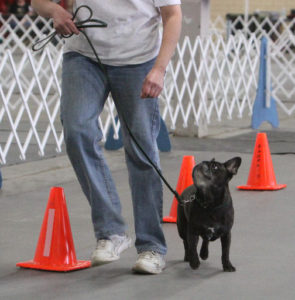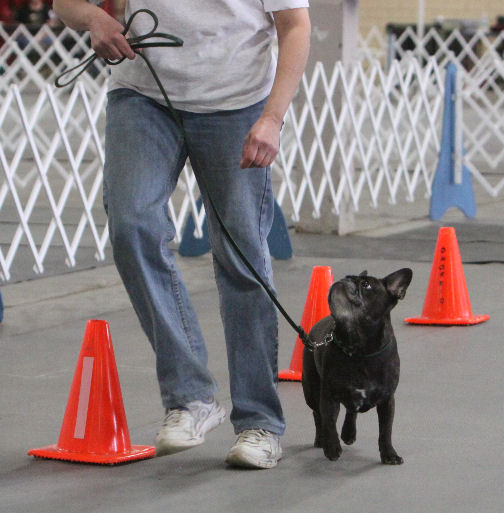One of our Rally student’s dogs was having an issue with lameness. A trip to the veterinary chiropractor yielded some relief, and some good advice. Whatever the dog does on one side, balance it with an equal exercise on the other side. Train both sides of your dog.
Regardless of your opinion of chiropractic practice for either people or dogs, the advice is good. Common sense tells you that all beings with bilateral symmetry, both dogs and people, should strive for equal strength. The classic example of asymmetrical development is baseball pitchers. The difference between their dominant arm and shoulder and the subordinate joints is dramatic.
So how does this apply in dog training? Most people will notice that their dogs have an easier time moving to one side than the other. Just like people, dogs have a dominant side they tend to favor. The “Spin!” game is usually where the dog’s preference shows most dramatically. It’s up to you, as your dog’s trainer and coach, to make sure the dog’s non-dominant side gets an equal, or greater, workout.
Why it matters
When your dog is young and healthy you may not see any obvious benefits resulting from two-sided training. But as your dog ages, their weaker side will be more prone to injuries, issues, and arthritis. When they’re old and creaky, an evenly-developed dog will have better muscle tone and be, perhaps, slightly less creaky.
If you’ve ever trained your dog in Obedience, you know that it’s almost exclusively performed with the dog on your left side. And some Obedience competitors question the need for training on both sides. After all, if dogs are always supposed to “Heel!” on the left, why bother with opposite-side practice?
There are obvious benefits for even muscle and balance strengthening. The less-apparent reason is to keep your dog’s attention and interest. You know that dogs love routine and patterns. Given the opportunity, dogs will follow known patterns and even try to anticipate the goal of any exercise. To avoid anticipation (which gets a disqualification in Obedience), it’s a good idea to switch up your training. It keeps sessions fresh and interesting for both of you.
Do it the “other” way

We also teach Rally, which is a bit more evenly distributed between left and right. Your dog still maintains heel position on your left, but many Rally signs have both left and right variants – 360 degree turns both ways, 270s both ways, etc. Even the Spiral signs have two options – either “Dog Inside” (closer to the pylons) or “Dog Outside” (handler closer to the pylons). This creates both inside and outside turns for your dog, balancing bilateral training exercises.
It’s easy enough to set up a mini-course with these easy heeling exercises. You don’t have to have cones or pylons, just three (or four) similarly-sized objects you and your dog can heel around, and the space to do it. If you want the official instructions, the Rally signs are readily available online.
Both sides of the coin
We’re always surprised when one of our students tells us their dog “only” goes one way on a behavior like “Spin!” or “Roll Over!” It may be easier to indulge your dog’s “handedness” preference, but it’s not what’s best for your dog. Train on both sides of your dog. Make a point of working the “hard” side more than the other. Your dog will be in better physical shape, and their physiology and gait will stay strong.
As with all dog training, your dog may resist your emphasis on their “off” side. Like all dog training, the most difficult part is patience. And rewards. The more difficult something is for your dog, the more valuable the reward should be. Make it worth your dog’s time to expend the effort. We all work a little more diligently for a great pay day.







